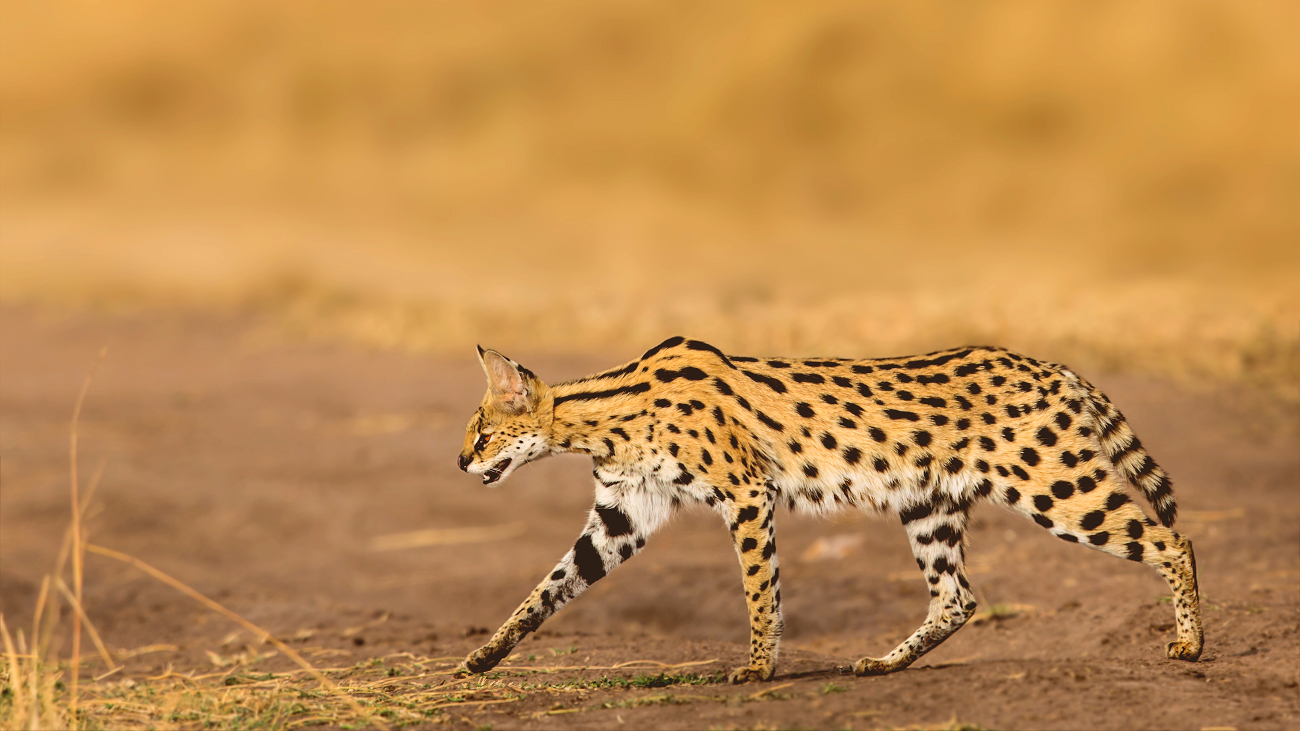- Home
- Conservancy
- Serval Cat
Description
The serval is a slender, medium-sized cat; it stands 54–62 centimetres (21–24 in) at the shoulder and weighs 8–18 kilograms (18–40 lb), but females tend to be lighter. The head-and-body length is typically between 67 and 100 centimetres (26 and 39 in). Males tend to be sturdier than females. Prominent characteristics include the small head, large ears, spotted and striped coat, long legs and a black-tipped tail that is around 30 centimetres (12 in) long. In fact, the serval has the longest legs of any cat relative to its body size, likely due to the greatly elongated metatarsal bones in the feet. The toes are elongated as well, and unusually mobile.
The coat is basically golden-yellow to buff, and extensively marked with black spots and stripes. The spots show great variation in size. Melanistic servals are also known. Facial features include the brownish or greenish eyes, white whiskers on the snout and near the ears, ears as large as those of a domestic cat (but large relative to the size of the head) and black on the back with a white horizontal band in the middle, whitish chin, and spots and streaks on the cheeks and the forehead. Three to four black stripes run from the back of the head onto the shoulders, and then break into rows of spots.
The white underbelly has dense and fluffy basal fur, and the soft guard hairs (the layer of fur protecting the basal fur) are 5–10 centimetres (2.0–3.9 in) long. Guard hairs are up to 3 centimetres (1.2 in) long on the neck, back and the flanks, and are merely 1 centimetre (0.4 in) long on the face. The closely set ears are black on the back with a horizontal white band; the ears can rotate up to 180 degrees independently of each other. The serval has a good sense of smell, hearing and vision.
Fun Facts
The serval is active in the day as well as at night; activity might peak in early morning, around twilight and at midnight. Servals might be active for a longer time on cool or rainy days. During the hot midday, they rest or groom themselves in the shade of bushes and grasses. Servals remain cautious of their vicinity, though they may be less alert when no large carnivores or prey animals are around. Serval walk as much as 2–4 kilometres (1.2–2.5 mi) every night. Servals will often use special trails to reach certain hunting areas. A solitary animal, there is little social interaction among servals except in the mating season, when pairs of opposite sexes may stay together. The only long-lasting bond appears to be of the mother and her cubs, which leave their mother only when they are a year old.
Both males and females establish home ranges, and are most active only in certain regions ('core areas') within them. The area of these ranges can vary from 10 to 32 square kilometres (3.9 to 12.4 sq mi); prey density, availability of cover and human interference could be significant factors in determining their size. Home ranges might overlap extensively, but occupants show minimal interaction. Aggressive encounters are rare, as servals appear to mutually avoid one another rather than fight and defend their ranges. Agonistic behaviour involves vertical movement of the head (contrary to the horizontal movement observed in other cats), raising the hair and the tail, displaying the teeth and the white band on the ears, and yowling. Individuals mark their ranges and preferred paths by spraying urine on nearby vegetation, dropping scats along the way, and rubbing their mouth on grasses or the ground while releasing saliva. Servals tend to be sedentary, shifting only a few kilometres away even if they leave their range.
The serval is vulnerable to hyaenas and wild dogs. It will seek cover to escape their view, and, if the predator is very close, immediately flee in long leaps, changing its direction frequently and with the tail raised. The serval is an efficient, though not frequent, climber; an individual was observed to have climbed a tree to a height of more than 9 metres (30 ft) to escape dogs. Like many cats, the serval is able to purr; it also has a high-pitched chirp, and can hiss, cackle, growl, grunt and meow.
